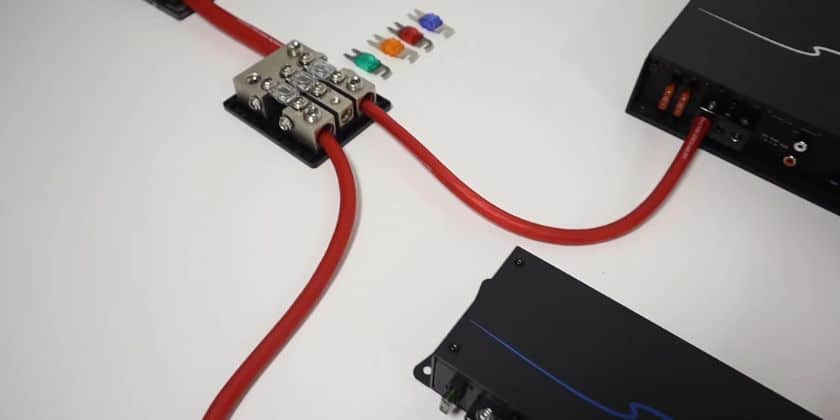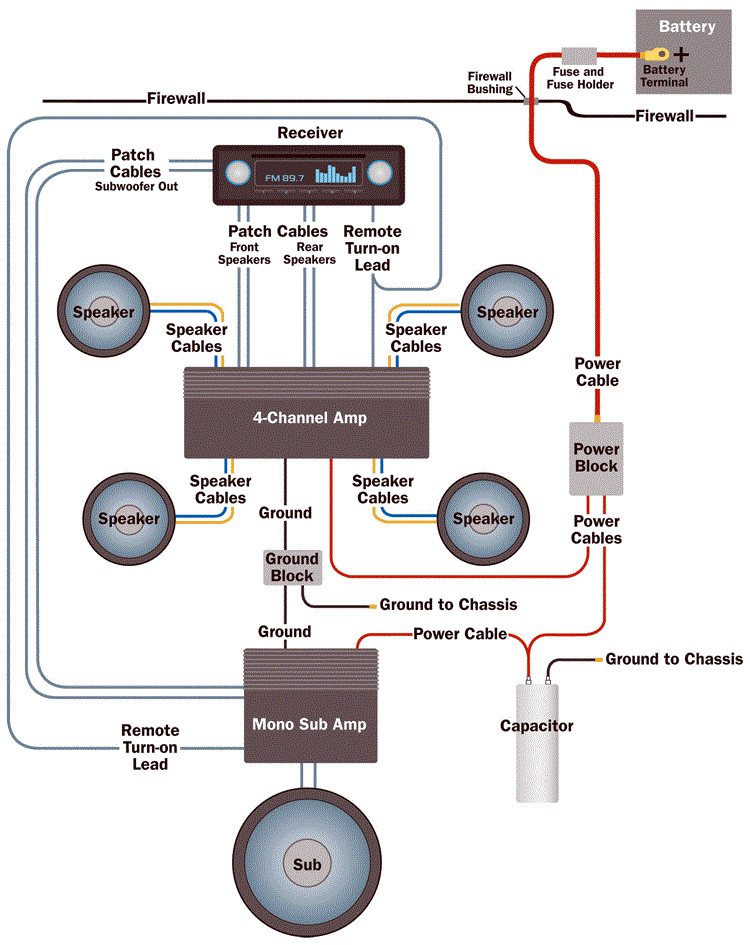
The easiest way to hook up two car amplifiers with a single power wire is by using a distribution block. It’ll take a primary power wire as its input and the two mini-power wires (that’ll connect to the amps) as outputs.
You can do the same with ground wires too.
Why Do You Need Multiple Amplifiers In Your Vehicle?
A single 4-channel or 5-channel amplifier is enough for most car audio setups. But what if you want a top-end audio system with 6-8 car speakers and 2-3 subwoofers?
A single amplifier can’t handle such a large number of speakers. Therefore, we’ll need an extra amplifier to share some of the power load.
But the biggest complaint against multiple car amplifiers is their complex installation process and cable clutter. And it is valid to some extent.
To help you out, we’ll discuss installing two amps with a single power wire in this blog post.
How to Hook up 2 Amps With 1 Power Wire?

Get Required Tools
For the most part, we’ll use the standard tools required in the amp installation process, such as wire crimpers, grommets, butt connectors, zip ties, and fuses.
You can buy them individually from any store or as an amp installation kit.
The only addition will be that of a distribution block. It’s a device that takes power as input from one source and distributes it to multiple output sources. You can think of it as an electrical extension board for car audio.
Do Initial Calculations
Before starting the installation process, you need to check the power requirements of your system. So that you can get power and ground wires with the correct gauge.
As we’re using a distribution block, we’ll need one bigger power wire from the battery to the distribution block and two smaller-sized power cables from the distribution block to the amplifiers.
The gauge for smaller power wires can be found using this formula: I=P/V, where P is the amplifier’s power delivery, and V is the system voltage. This formula will give you the amps your amplifier (also known as the current draw) requires after dividing the value of ‘I’ by the amp’s efficiency.
Once you’ve determined the current draw of your amp, find the correct wire gauge using this chart.

Credits: Crutchfield.com
To find the gauge for the primary power wire, add the current draws of two amps and repeat the previous step.
Afterward, you should pick three ground wires (one primary and two small-sized) with gauges similar to their power wire counterparts.
Run the Power Wire From Battery to the Amplifiers
Once you’ve gathered all the wires and accessories, it’s time to start the installation process.
First, disconnect the negative battery terminal and ensure it doesn’t touch any metal part of the vehicle body.
Then, connect one end of the primary power wire to the positive battery terminal. Run this wire from the battery and connect it to the input terminal of the distribution block.
After that, connect one end of the two small-sized power wires to the output terminals of the distributor block. And connect their other ends to the 12V terminals of the amplifiers.
One important thing to note is that all three wires should be inline-fused appropriately.
The sum of the amperage of small wires’ fuses will be the amperage of the primary power wire’s fuse.
Run the Ground Wire From the Amplifier to the Vehicle Body
The same steps will be repeated for ground wires.
You need to connect one end of small-sized ground wires to the ground terminals of the amplifiers. And connect their other ends to the output terminals of the second distribution block, also known as the grounding block.
Then, connect one end of the primary ground wire to the grounding block’s input terminal and the other to the grounding spot.
Ensure the grounding spot is paint and rust-free; otherwise, you can have bad grounding-related issues.
Add the Remote turn-on Cables
You can handle remote turn-on wires in multi-amp installations in many different ways.
The first method uses a Y-splitter to split the remote turn-on wire coming from the head unit into two wires and then connect each to an amplifier.
The second method is connecting the remote turn-on wire to a single amplifier and then running an extra cable from the remote turn-on terminal of the first amp to that of the second amp.
In some cases, the turn-on signal from the head unit isn’t powerful enough to turn on two amps at one time. If that’s the case with your vehicle, you should install a relay to turn your amps on or off manually.
Related Post – Where to Connect Remote Wire for Car Amplifier?
Connect Head Unit With The Amplifiers
The connections between the unit and the amplifiers will depend on how many pre-amp RCA outputs your head unit has.
If your head unit has enough of them, you must connect each pre-out set to its respective amps.
If your head unit has fewer pre-outs, you’ll need a Y-splitter to create extra pre-outs and connect them to the amps – or use the RCA pass-through functionality of your amp(s) if they have any.
But if you’re using a factory head unit with no RCA outputs, the setup will get much more complex as you’ll need to install a line-out converter. In such a situation, I suggest upgrading to an aftermarket head unit to simplify the installation.
Connect Speakers and Subwoofers to the Amplifiers
In the last step, we’ll connect positive and negative wires from speakers and subwoofers to the amplifiers.
Test The System
Once you’re sure that you’ve made all the wiring connections, reconnect the negative battery terminal.
Then, turn on the head unit and play music to see if everything works.
How to install two amps in a car diagram
To help you visualize the above process, below is a simple wiring diagram of this setup.

As you can see, red and black represent the power and ground wires. In contrast, the blue and brown colors are used for the speaker and RCA wires.
2 amps 1 sub wiring diagram

Conclusion
Installing multiple amplifiers in your vehicle can make your audio system complex and messy. But you can reduce this risk to a great degree by using distribution blocks on power and ground wires.
These blocks don’t cost much but can take your cable management game to the next level.
Frequently Asked Questions
Can You Have Multiple Amps In One Car Audio System?
You can have multiple amps in a single-car audio system if your alternator can power them efficiently.
How To Wire Two Car Amps Without A Distribution Block?
To wire two car amps without a distribution block, run a single power wire from the positive battery terminal to the 12V terminal of the first amplifier. Then, run a small-length power wire of the same gauge from the first amp’s 12V terminal to that of the second amp.
How To Hook Up Two Car Amps With 1 RCA?
You can hook up two car amplifiers with a single RCA pre-out using a Y-adapter.
Can I Use The Same Ground For 2 Car Amps?
Yes, you can use the same ground for two car amps if the wire is of the proper gauge, the ground spot is painted and rust-free, and the ground connection you make is tight and secure.
How Long Can A Ground Wire Be For A Car Amp?
The ground wire should be kept as short as possible, ideally. But for practical scenarios, you’re okay if it’s less than 18 inches long.
References: